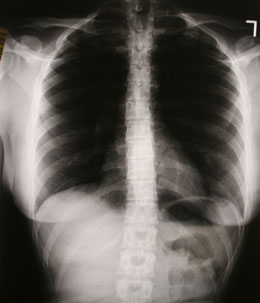Sternum fracture is the fracture caused to the breastbone, that is located in the center of the chest. This article provides information regarding the same.

A fractured sternum is often observed in about 5 to 8% of people, who experience significant blunt trauma to the chest. This can occur due to vehicle accidents, when the chest forcefully strikes a steering wheel or dashboard, or due to a seat belt. This fracture can interfere with breathing, thereby making it a painful task. It may also indicate serious internal injuries associated to the heart and the lungs.
Causes
The most common causes of this fracture are vehicle collisions, mostly, car accidents. If the driver is not wearing a seat belt, the chest of the driver may strike the steering wheel with an impact leading to a chest injury. If the driver does wear a seat belt, the shoulder component of the seat belt may injure the chest if it is worn without the lap component. The other prominent cause is when the person suddenly flexes the chest. Such an injury is caused in the absence of an impact. Athletes, such as wrestlers, often experience a form of sternum fracture called stress fracture. Women affected by osteoporosis and thoracic kyphosis are also prone to this fracture.
Symptoms
The most important sign of a fractured sternum is the crunching sound that is made when the ends of the broken bones rub together. The person may experience chest pain, tenderness, bruising as well as swelling around the fractured area. The fracture is more prominently visible when the person breathes, and the bones tend to bend or are deformed by forming a step at the junction of the injury during palpation. They can also show abnormalities on the electrocardiograms. It is the upper and middle parts of the breastbone that are more prone to fracture; however, most of these fractures occur below the sternal angle.
Treatment
Normally, X-rays of the chest are taken in people who have undergone a chest trauma or have any symptoms of breastbone fracture. When the fracture is minor, it is often treated with analgesics and restrictions on movements for a few weeks. Pain killers help the patient to expand the chest sufficiently and also prevent pneumonia. If the breastbone is displaced, it may require a minimally invasive surgery. A small incision is made into the chest so that a hook can be used to pull the sternum back into its proper position. In case of a severe fracture, surgical fixation may be required. The recovery time majorly depends on the severity of the fracture. Since the affected area cannot be kept in a cast, the patient is required to take self-care measures to recover as soon as possible.
The basic steps that the patient may have to follow is to rest the injured area. Complete bed rest with sufficient support to the fractured site is recommended so that any movement does not cause excruciating pain. For the first two weeks, movements have to be limited as much as possible. However, that does not mean, that the patient does not walk at all. A little walking around the house may help in the healing process. After a few weeks, the patient may slowly start performing normal day-to-day activities. The doctor may recommend physical therapy, which may help strengthen the chest muscles.
People should not delay in getting treatment for sternal fracture. If the fracture is not treated well in time, it can also lead to deformities in the sternum and other complications.
Disclaimer:
This Buzzle article is for informative purposes only, and should not be used as a replacement for expert medical advice.


 A fractured sternum is often observed in about 5 to 8% of people, who experience significant blunt trauma to the chest. This can occur due to vehicle accidents, when the chest forcefully strikes a steering wheel or dashboard, or due to a seat belt. This fracture can interfere with breathing, thereby making it a painful task. It may also indicate serious internal injuries associated to the heart and the lungs.
A fractured sternum is often observed in about 5 to 8% of people, who experience significant blunt trauma to the chest. This can occur due to vehicle accidents, when the chest forcefully strikes a steering wheel or dashboard, or due to a seat belt. This fracture can interfere with breathing, thereby making it a painful task. It may also indicate serious internal injuries associated to the heart and the lungs.